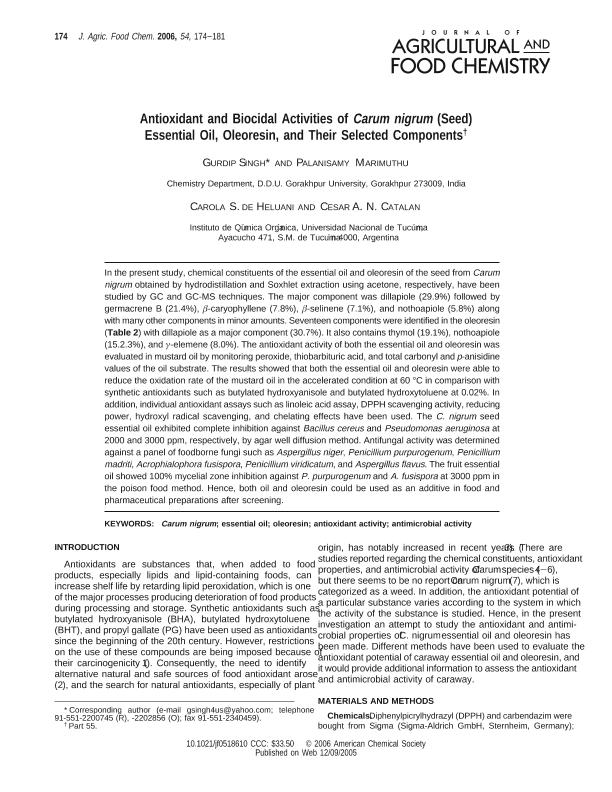Mostrar el registro sencillo del ítem
dc.contributor.author
Singh, Gurdip

dc.contributor.author
Marimuthu, Palanisamy
dc.contributor.author
De Heluani, Carola S.
dc.contributor.author
Catalan, Cesar Atilio Nazareno

dc.date.available
2020-03-13T19:11:33Z
dc.date.issued
2006-01
dc.identifier.citation
Singh, Gurdip; Marimuthu, Palanisamy; De Heluani, Carola S.; Catalan, Cesar Atilio Nazareno; Antioxidant and biocidal activities of Carum nigrum (Seed) essential oil, oleoresin, and their selected components; American Chemical Society; Journal of Agricultural and Food Chemistry; 54; 1; 1-2006; 174-181
dc.identifier.issn
0021-8561
dc.identifier.uri
http://hdl.handle.net/11336/99544
dc.description.abstract
In the present study, chemical constituents of the essential oil and oleoresin of the seed from Carum nigrum obtained by hydrodistillation and Soxhlet extraction using acetone, respectively, have been studied by GC and GC-MS techniques. The major component was dillapiole (29.9%) followed by germacrene B (21.4%), β-caryophyllene (7.8%), β-selinene (7.1%), and nothoapiole (5.8%) along with many other components in minor amounts: Seventeen components were identified in the oleoresin (Table 2) with dillapiole as a major component (30.7%). It also contains thymol (19.1%), nothoapiole (15.2.3%), and γ-elemene (8.0%). The antioxidant activity of both the essential oil and oleoresin was evaluated in mustard oil by monitoring peroxide, thiobarbituric acid, and total carbonyl and p-anisidine. values of the oil substrate. The results showed that both the essential oil and oleoresin were able to reduce the oxidation rate of the mustard oil in the accelerated condition at 60°C in comparison with synthetic antioxidants such as butylated hydroxyanisole and butylated hydroxytoluene at 0.02%. In addition, individual antioxidant assays such as linoleic acid assay, DPPH scavenging activity, reducing power, hydroxyl radical scavenging, and chelating effects have been used. The C. nigrum seed essential oil exhibited complete inhibition against Bacillus cereus and Pseudomonas aeruginosa at 2000 and 3000 ppm, respectively, by agar well diffusion method. Antifungal activity was determined against a panel of foodborne fungi such as Aspergillus niger, Penicillium purpurogenum, Penicillium madriti, Acrophialophora fusispora, Penicillium viridicatum, and Aspergillus flavus. The fruit essential oil showed 100% mycelial zone inhibition against P. purpurogenum and A. fusispora at 3000 ppm in the poison food method. Hence, both oil and oleoresin could be used as an additive in food and pharmaceutical preparations after screening. © 2006 American Chemical Society.
dc.format
application/pdf
dc.language.iso
eng
dc.publisher
American Chemical Society

dc.rights
info:eu-repo/semantics/openAccess
dc.rights.uri
https://creativecommons.org/licenses/by-nc-sa/2.5/ar/
dc.subject
ANTIMICROBIAL ACTIVITY
dc.subject
ANTIOXIDANT ACTIVITY
dc.subject
CARUM NIGRUM
dc.subject
ESSENTIAL OIL
dc.subject
OLEORESIN
dc.subject.classification
Química Orgánica

dc.subject.classification
Ciencias Químicas

dc.subject.classification
CIENCIAS NATURALES Y EXACTAS

dc.title
Antioxidant and biocidal activities of Carum nigrum (Seed) essential oil, oleoresin, and their selected components
dc.type
info:eu-repo/semantics/article
dc.type
info:ar-repo/semantics/artículo
dc.type
info:eu-repo/semantics/publishedVersion
dc.date.updated
2020-03-11T18:34:23Z
dc.journal.volume
54
dc.journal.number
1
dc.journal.pagination
174-181
dc.journal.pais
Estados Unidos

dc.description.fil
Fil: Singh, Gurdip. Deen Dayal Upadhyay Gorakhpur University India; India
dc.description.fil
Fil: Marimuthu, Palanisamy. Deen Dayal Upadhyay Gorakhpur University India; India
dc.description.fil
Fil: De Heluani, Carola S.. Universidad Nacional de Tucumán; Argentina
dc.description.fil
Fil: Catalan, Cesar Atilio Nazareno. Consejo Nacional de Investigaciones Científicas y Técnicas. Centro Científico Tecnológico Conicet - Tucumán. Instituto de Química del Noroeste. Universidad Nacional de Tucumán. Facultad de Bioquímica, Química y Farmacia. Instituto de Química del Noroeste; Argentina. Universidad Nacional de Tucumán; Argentina
dc.journal.title
Journal of Agricultural and Food Chemistry

dc.relation.alternativeid
info:eu-repo/semantics/altIdentifier/url/https://pubs.acs.org/doi/pdf/10.1021/jf0518610
dc.relation.alternativeid
info:eu-repo/semantics/altIdentifier/doi/https://doi.org/10.1021/jf0518610
Archivos asociados
